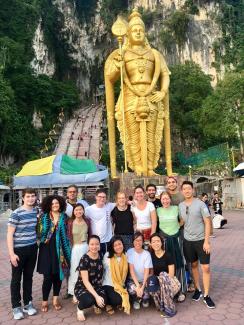
This Semester, a group of UPenn undergraduate students traveled to Malaysia and Singapore with Professor Teren Sevea and South Asia Center Associate Director Amelia Carter, as a part of the C.U. in Southeast Asia: Sufis and Gods course. Over a period of six days during spring break, students explored temples and shrines, in person, to receive a deeper understanding of the impact the Indian diaspora has on the region.
On day one of C.U. In Southeast Asia and Penn Global Seminar course “Sufis and Gods,” the group arrived safely to Singapore after some major delays caused by a snow storm in Philadelphia. They immediately began a walking tour of the countries Little India district, where they visited royal Sufi grave sites under threat of demolition, historic churches, important mosques and enjoyed South Indian cuisine at some of the country’s oldest restaurants.
On day two of "Sufis and Gods," students had a walking tour through Singapore’s Chinatown where they learned about the relationship between the immigrant Chinese and Tamil populations in the nation. First the students visited Muhammad Salleh Mosque & Maqam of Habib Noh, a mosque and Muslim mausoleum of Sufi saint Sayyid Habib Noh bin. Afterwards they drove to Thian Hock Keng, a temple built for the worship of Mazu, a Chinese sea goddess. Then students received a lecture on Telok Ayer Street, the original focal point of settlement in Chinatown.
Nagore Durgha was next up on our tour. At this shrine students learned about the Chulia population and it’s cultural influence on the area. We continued with a visit to Masjid Jamae, one of the earliest mosques in Singapore established by the Tamil Muslim community. Both the Tamil mosque and Sri Mariamman Temple, where we also stopped for a visit, stood out as an interesting example of Tamil/Chinese interaction in the case of Singapore.
The course was able to witness an evening ceremony at the Sri Veeramakaliamman Temple which is dedicated to the Hindu goddess Kali. The long day concluded with a tour through the Indian Heritage Centre which showcased the culture, heritage and history of Indian Singaporeans through creative and interactive exhibitions.
On day three of the students left Singapore and crossed the border into Malaysia. On the journey they visited Pulau Besar. This island became a place of pilgrimage to a large number of Indian Muslims in Malaysia. Many pilgrims still come to the island to visit a mausoleum believed to be of a Wali, Sultan Ariffin Syeikh Ismail Waliallah. Students learned that significant graves and Sufi shrines on the island are currently under threat or have already been torn down due to commercial development. The evening concluded with a walking tour of Malacca and stops at notable temples and historical sites.
The next day, the group resumed their walking tour of the city seeing major monuments and shrines along the way. Later they headed to the Batu Caves, one of Kuala Lumpur’s most well-known attractions. This limestone cave houses several significant Hindu shrines. It is guarded by a spear-toting gold statue of Hindu deity Lord Murugan, who plays a central role in the Malaysian Hindu community.
On day five of the group started the long journey to Penang after a short tour of Kuala Lumpur. Once there they visited a temple and mosque on Penang Hill and continued on with a walking tour of Penang city stopping for some important religious sites, conversations and lectures along the way.
On the final day students continued their walking tour of Penang visiting several key landmarks such as Khoo Khonsi Clan House, Kapitan Keling's Tomb as well as temples and mosques throughout Penang’s Little India. Afterward students returned to Singapore for one final meal at one of their most famed night markets and headed home to Philadelphia.
